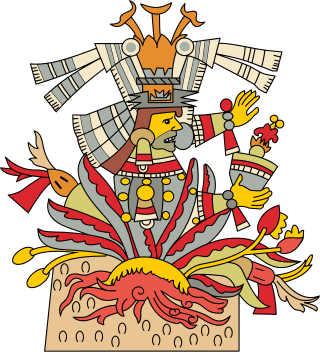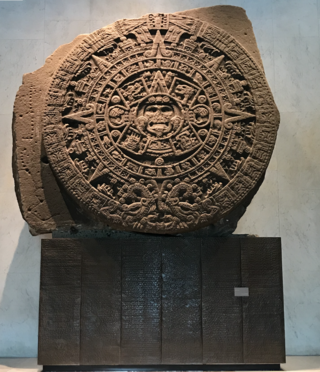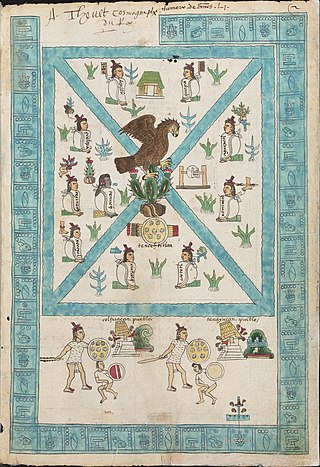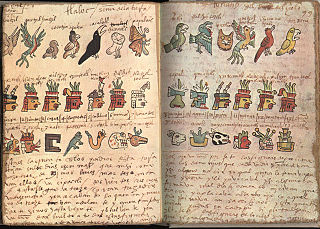Related Research Articles

Mayahuel is the female deity associated with the maguey plant among cultures of central Mexico in the Postclassic era of pre-Columbian Mesoamerican chronology, and in particular of the Aztec cultures. As the personification of the maguey plant, Mayahuel is also part of a complex of interrelated maternal and fertility goddesses in Aztec religion and is also connected with notions of fecundity and nourishment.

The Aztec or Mexica calendar is the calendrical system used by the Aztecs as well as other Pre-Columbian peoples of central Mexico. It is one of the Mesoamerican calendars, sharing the basic structure of calendars from throughout the region.
Tlatoani is the Classical Nahuatl term for the ruler of an āltepētl, a pre-Hispanic state. It is the noun form of the verb "tlahtoa" meaning "speak, command, rule". As a result, it has been variously translated in English as "king", "ruler", or "speaker" in the political sense. Above a tlahtoani is the Huey Tlahtoani, sometimes translated as "Great Speaker", though more usually as "Emperor". A cihuatlatoani is a female ruler, or queen regnant.

The tōnalpōhualli, meaning "count of days" in Nahuatl, is a Mexica version of the 260-day calendar in use in pre-Columbian Mesoamerica. This calendar is solar and consists of 20 13-day periods. Each trecena is ruled by a different deity. Graphic representations for the twenty day names have existed among certain ethnic, linguistic, or archaeologically identified peoples.

The Aztecs were a Pre-Columbian Mesoamerican people of central Mexico in the 14th, 15th, and 16th centuries. They called themselves Mēxihcah.

Aztec codices are Mesoamerican manuscripts made by the pre-Columbian Aztec, and their Nahuatl-speaking descendants during the colonial period in Mexico.

The Codex Magliabechiano is a pictorial Aztec codex created during the mid-16th century, in the early Spanish colonial period. It is representative of a set of codices known collectively as the Magliabechiano Group. The Codex Magliabechiano is based on an earlier unknown codex, which is assumed to have been the prototype for the Magliabechiano Group. It is named after Antonio Magliabechi, a 17th-century Italian manuscript collector, and is held in the Biblioteca Nazionale Centrale, Florence, Italy.

The Codex Borgia, also known as Codex Borgianus, Manuscrit de Veletri and Codex Yohualli Ehecatl, is a pre-Columbian Middle American pictorial manuscript from Central Mexico featuring calendrical and ritual content, dating from the 16th century. It is named after the 18th century Italian cardinal, Stefano Borgia, who owned it before it was acquired by the Vatican Library after the cardinal's death in 1804.
Tlamatini is a Nahuatl language word meaning "someone who knows something", generally translated as "wise man". The word is analyzable as derived from the transitive verb mati "to know" with the prefix tla- indicating an unspecified inanimate object translatable by "something" and the derivational suffix -ni meaning "a person who is characterized by ...": hence tla-mati-ni "a person who is characterized by knowing something" or more to the point "a knower".
Mesoamerica, along with Mesopotamia and China, is one of three known places in the world where writing is thought to have developed independently. Mesoamerican scripts deciphered to date are a combination of logographic and syllabic systems. They are often called hieroglyphs due to the iconic shapes of many of the glyphs, a pattern superficially similar to Egyptian hieroglyphs. Fifteen distinct writing systems have been identified in pre-Columbian Mesoamerica, many from a single inscription. The limits of archaeological dating methods make it difficult to establish which was the earliest and hence the progenitor from which the others developed. The best documented and deciphered Mesoamerican writing system, and the most widely known, is the classic Maya script. Earlier scripts with poorer and varying levels of decipherment include the Olmec hieroglyphs, the Zapotec script, and the Isthmian script, all of which date back to the 1st millennium BC. An extensive Mesoamerican literature has been conserved, partly in indigenous scripts and partly in postconquest transcriptions in the Latin script.

The traditions of indigenous Mesoamerican literature extend back to the oldest-attested forms of early writing in the Mesoamerican region, which date from around the mid-1st millennium BCE. Many of the pre-Columbian cultures of Mesoamerica are known to have been literate societies, who produced a number of Mesoamerican writing systems of varying degrees of complexity and completeness. Mesoamerican writing systems arose independently from other writing systems in the world, and their development represents one of the very few such origins in the history of writing.

The Codex Tudela is a 16th-century pictorial Aztec codex. It is based on the same prototype as the Codex Magliabechiano, the Codex Ixtlilxochitl, and other documents of the Magliabechiano Group.

Mixtec writing originated as a logographic writing system during the Post-Classic period in Mesoamerican history. Records of genealogy, historic events, and myths are found in the pre-Columbian Mixtec codices. The arrival of Europeans in 1520 AD caused changes in form, style, and the function of the Mixtec writings. Today these codices and other Mixtec writings are used as a source of ethnographic, linguistic, and historical information for scholars, and help to preserve the identity of the Mixtec people as migration and globalization introduce new cultural influences.

Robert E. Lee Chadwick was an American anthropologist and archeologist, primarily known for his contributions to the Handbook of Middle American Indians.
New Philology generally refers to a branch of Mexican ethnohistory and philology that uses colonial-era native language texts written by Indians to construct history from the indigenous point of view. The name New Philology was coined by James Lockhart to describe work that he and his doctoral students and scholarly collaborators in history, anthropology, and linguistics had pursued since the mid-1970s. Lockhart published a great many essays elaborating on the concept and content of the New Philology and Matthew Restall published a description of it in the Latin American Research Review.

Tenayuca is a pre-Columbian Mesoamerican archaeological site in the Valley of Mexico. In the Postclassic period of Mesoamerican chronology, Tenayuca was a settlement on the former shoreline of the western arm of Lake Texcoco. It was located approximately 10 kilometres (6.2 mi) to the northwest of Tenochtitlan.
Karl Anton Nowotny was an Austrian ethnographer, art historian and academic, specialising in the study of Mesoamerican cultures. He is most renowned for his analyses and reproductions of Mesoamerican codices, and his commentaries on their iconography and symbolisms.

Xicalcoliuhqui is a common motif in Mesoamerican art. It is composed of three or more steps connected to a hook or spiral, reminiscent of a "greek-key" meander. Pre-Columbian examples may be found on everything from jewelry, masks, ceramics, sculpture, textiles and featherwork to painted murals, codices and architectural elements of buildings. The motif has been in continual use from the pre-Columbian era to the present.
Frances F. Berdan is an American archaeologist specializing in the Aztecs and professor emerita of anthropology at California State University, San Bernardino.

Mesoamerican codices are manuscripts that present traits of the Mesoamerican indigenous pictoric tradition, either in content, style, or in regards to their symbolic conventions. The unambiguous presence of Mesoamerican writing systems in some of these documents is also an important, but not defining, characteristic, for Mesoamerican codices can comprise pure pictorials, native cartographies with no traces of glyphs on them, or colonial alphabetic texts with indigenous illustrations. Perhaps the best-known examples among such documents are Aztec codices, Maya codices, and Mixtec codices, but other cultures such as the Tlaxcaltec, the Purépecha, the Otomi, the Zapotecs, and the Cuicatecs, are creators of equally relevant manuscripts.
References
- Boone, Elizabeth Hill (November 2006). "Curriculum Vitae". Newcomb Art Department, Tulane University. Archived from the original (Microsoft Word doc) on July 20, 2011. Retrieved 2008-05-07.
- Miller, Mary (2001). "Stories in Red and Black: Pictorial Histories of the Aztecs and Mixtecs [review]". Hispanic American Historical Review. Durham, NC: Duke University Press. 81 (1): 139–140. doi:10.1215/00182168-81-1-139. OCLC 205911461. S2CID 144784605.
- "National Gallery of Art Center for Advanced Study in the Visual Arts Announces 2007–2008 Appointments" (Press release). National Gallery of Art Press Office. November 13, 2007. Archived from the original on May 15, 2008. Retrieved 2008-05-07.
- Quilter, Jeffrey (December 2001). "Review". The Art Bulletin. Providence, RI: College Art Association. 83 (4): 762–765. doi:10.2307/3177232. ISSN 1559-6478. JSTOR 3177232. OCLC 93037864. Archived from the original (online reproduction) on January 10, 2008. Retrieved 2008-05-08.
- Sisson, Edward B. (December 1983). "Recent Work on the Borgia Group Codices". Current Anthropology . Chicago, IL: University of Chicago Press, sponsored by Wenner-Gren Foundation for Anthropological Research. 24 (5): 653–656. doi:10.1086/203067. OCLC 62217742. S2CID 144846753.